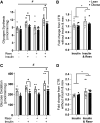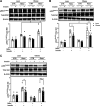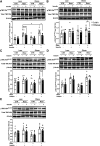Effect of resveratrol on insulin action in primary myotubes from lean individuals and individuals with severe obesity
- PMID: 38324260
- PMCID: PMC11193525
- DOI: 10.1152/ajpendo.00299.2023
Effect of resveratrol on insulin action in primary myotubes from lean individuals and individuals with severe obesity
Abstract
Resveratrol, a natural polyphenol compound contained in numerous plants, has been proposed as a treatment for obesity-related disease processes such as insulin resistance. However, in humans there are conflicting results concerning the efficacy of resveratrol in improving insulin action; the purpose of the present study was to determine whether obesity status (lean, severely obese) affects the response to resveratrol in human skeletal muscle. Primary skeletal muscle cells were derived from biopsies obtained from age-matched lean and insulin-resistant women with severe obesity and incubated with resveratrol (1 µM) for 24 h. Insulin-stimulated glucose oxidation and incorporation into glycogen, insulin signal transduction, and energy-sensitive protein targets [AMP-activated protein kinase (AMPK), Sirt1, and PGC1α] were analyzed. Insulin-stimulated glycogen synthesis, glucose oxidation, and AMPK phosphorylation increased with resveratrol incubation compared with the nonresveratrol conditions (main treatment effect for resveratrol). Resveratrol further increased IRS1, Akt, and TBC1D4 insulin-stimulated phosphorylation and SIRT1 content in myotubes from lean women, but not in women with severe obesity. Resveratrol improves insulin action in primary human skeletal myotubes derived from lean women and women with severe obesity. In women with obesity, these improvements may be associated with enhanced AMPK phosphorylation with resveratrol treatment.NEW & NOTEWORTHY A physiologically relevant dose of resveratrol increases insulin-stimulated glucose oxidation and glycogen synthesis in myotubes from individuals with severe obesity. Furthermore, resveratrol improved insulin signal transduction in myotubes from lean individuals but not from individuals with obesity. Activation of AMPK plays a role in resveratrol-induced improvements in glucose metabolism in individuals with severe obesity.
Keywords: glucose metabolism; human skeletal muscle; insulin signaling; obesity; resveratrol.
Conflict of interest statement
No conflicts of interest, financial or otherwise, are declared by the authors.
Figures





Similar articles
-
Electrical pulse stimulation induces differential responses in insulin action in myotubes from severely obese individuals.J Physiol. 2019 Jan;597(2):449-466. doi: 10.1113/JP276990. Epub 2018 Dec 2. J Physiol. 2019. PMID: 30414190 Free PMC article.
-
Differential acute and chronic responses in insulin action in cultured myotubes following from nondiabetic severely obese humans following gastric bypass surgery.Surg Obes Relat Dis. 2017 Nov;13(11):1853-1862. doi: 10.1016/j.soard.2017.05.019. Epub 2017 May 26. Surg Obes Relat Dis. 2017. PMID: 28673470
-
Effects of Physiological Doses of Resveratrol and Quercetin on Glucose Metabolism in Primary Myotubes.Int J Mol Sci. 2021 Jan 30;22(3):1384. doi: 10.3390/ijms22031384. Int J Mol Sci. 2021. PMID: 33573178 Free PMC article.
-
Metabolism and insulin signaling in common metabolic disorders and inherited insulin resistance.Dan Med J. 2014 Jul;61(7):B4890. Dan Med J. 2014. PMID: 25123125 Review.
-
[The role of SIRT1 in the pathogenesis of insulin resistance in skeletal muscle].Postepy Hig Med Dosw (Online). 2015 Jan 16;69:63-8. doi: 10.5604/17322693.1136379. Postepy Hig Med Dosw (Online). 2015. PMID: 25614674 Review. Polish.
Cited by
-
A Combination of Resveratrol and Quercetin Prevents Sarcopenic Obesity: Its Role as a Signaling Inhibitor of Myostatin/ActRIIA and ActRIIB/Smad and as an Enhancer of Insulin Actions.Int J Mol Sci. 2025 May 21;26(10):4952. doi: 10.3390/ijms26104952. Int J Mol Sci. 2025. PMID: 40430092 Free PMC article.
-
Utilization of edible poultry slaughter residues: A chicken-liver hydrolysate with glucose-lowering ability and upregulating glycogenesis in type II diabetes.Poult Sci. 2025 Jan;104(1):104517. doi: 10.1016/j.psj.2024.104517. Epub 2024 Nov 7. Poult Sci. 2025. PMID: 39571203 Free PMC article.
-
Polyphenols and Exercise in Mitochondrial Biogenesis: Focus on Age-Related CNS Disorders.Mol Neurobiol. 2025 Jun 13. doi: 10.1007/s12035-025-05121-y. Online ahead of print. Mol Neurobiol. 2025. PMID: 40512338 Review.
References
-
- Lagouge M, Argmann C, Gerhart-Hines Z, Meziane H, Lerin C, Daussin F, Messadeq N, Milne J, Lambert P, Elliott P, Geny B, Laakso M, Puigserver P, Auwerx J. Resveratrol improves mitochondrial function and protects against metabolic disease by activating SIRT1 and PGC-1α. Cell 127: 1109–1122, 2006. doi:10.1016/j.cell.2006.11.013. - DOI - PubMed
MeSH terms
Substances
Grants and funding
LinkOut - more resources
Full Text Sources

